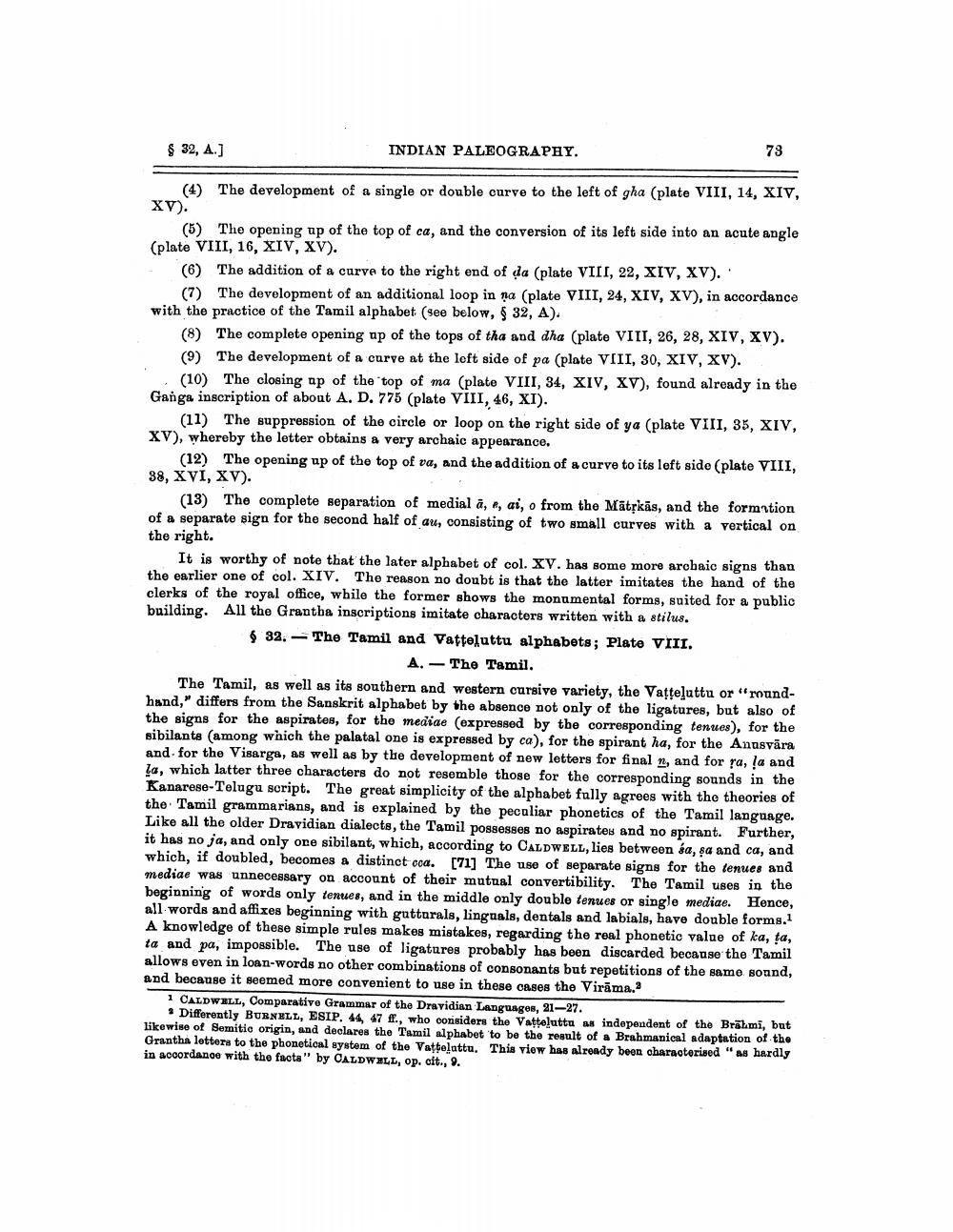________________
$ 32, A.]
INDIAN PALEOGRAPHY.
73
-
(4) The development of a single or double curve to the left of gha (plate VIII, 14, XIV, XV).
(5) The opening up of the top of ca, and the conversion of its left side into an acute angle (plate VIII, 16, XIV, XV).
(6) The addition of a curve to the right end of da (plate VIII, 22, XIV, XV).
(7) The development of an additional loop in na (plate VIII, 24, XIV, XV), in accordance with the practice of the Tamil alphabet (see below, 32, A).
(8) The complete opening up of the tops of tha and dha (plate VIII, 26, 28, XIV, XV). (9) The development of a curve at the left side of pa (plate VIII, 30, XIV, XV).
(10) The closing up of the top of ma (plate VIII, 34, XIV, XV), found already in the Ganga inscription of about A. D. 775 (plate VIII, 46, XI).
(11) The suppression of the circle or loop on the right side of ya (plate VIII, 35, XIV, XV), whereby the letter obtains a very archaic appearance.
(12) The opening up of the top of va, and the addition of a curve to its left side (plate VIII, 88, XVI, XV).
(13) The complete separation of medial a, a, ai, o from the Mātņkās, and the formation of a separate sign for the second half of au, consisting of two small curves with a vertical on the right.
It is worthy of note that the later alphabet of col. XV. has some more arobaic signs than the earlier one of col. XIV. The reason no doubt is that the latter imitates the hand of the clerks of the royal office, while the former shows the monumental forms, suited for a public building. All the Grantba inscriptions imitate characters written with a stilus. 32. - The Tamil and Vatteluttu alphabets; Plato VIII.
A. - The Tamil. The Tamil, as well as its southern and western cursive variety, the Vatteluttu or 'roundhand," differs from the Sanskrit alphabet by the absence not only of the ligatures, but also of the signs for the aspirates, for the mediae (expressed by the corresponding tenues), for the sibilants (among which the palatal one is expressed by ca), for the spirant ha, for the Anasvāra and for the Visarga, as well as by the development of new letters for final n, and for ra, la and la, which latter three characters do not resemble those for the corresponding sounds in the Kanarese-Telugu script. The great simplicity of the alphabet fully agrees with the theories of the Tamil grammarians, and is explained by the peculiar phonetics of the Tamil language. Like all the older Dravidian dialects, the Tamil possesses no aspirates and no spirant. Further, it has no ja, and only one sibilant, which, according to CALDWELL, lies between ea, şa and ca, and which, if doubled, becomes a distinct cca. [71] The use of separate signs for the tenues and mediae was unnecessary on account of their mutual convertibility. The Tamil uses in the beginning of words only tenues, and in the middle only double tenues or single mediae. Hence, all words and affixes beginning with gutturals, linguals, dentals and labials, have double forms. A knowledge of these simple rules makes mistakes, regarding the real phonetic value of ka, ta, ta and pa, impossible. The use of ligatures probably has been discarded because the Tamil allows even in loan-words no other combinations of consonants but repetitions of the same soand, and because it seemed more convenient to use in these cases the Virāma.
1 CALDWELL, Comparative Grammar of the Dravidian Languages, 21-27.
. Differently BURNELL, ESIP. 44, 47 ff., who considers the Vatteluttu a independent of the Brāhmi, but likewise of Semitic origin, and declares the Tamil alphabet to be the result of a Brahmanical adaptation of the Grantha letters to the phonetical system of the Vattelattu. This viow has already been characterised" hardly in accordance with the facta" by CALDWELL, op. cit., 9.




